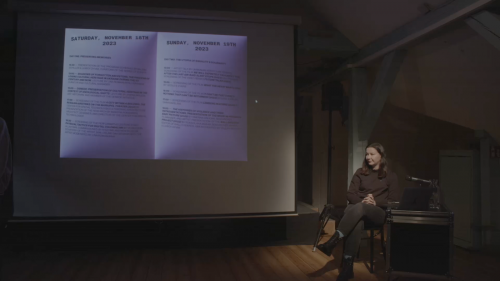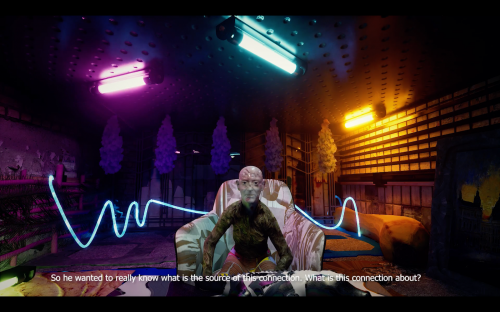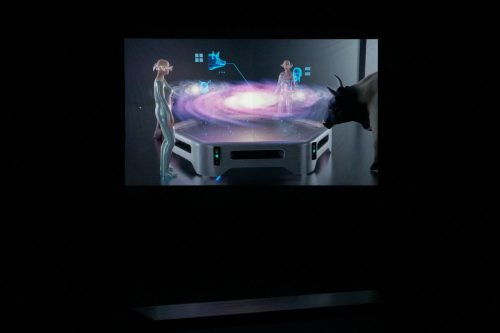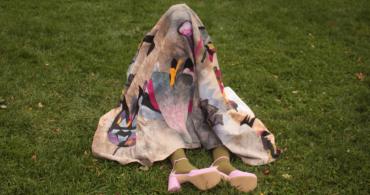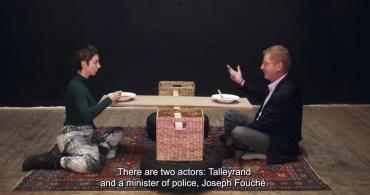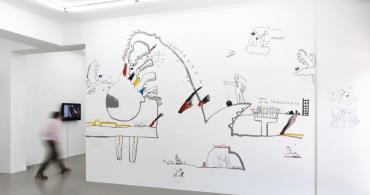The second stage of the event was focused on the thoroughness of working with history and the testimonies of victims. Thus, the program included a screening of
“Lemberg Machine” (2023) by Dana Kavelina, an animated film about the 1941 pogrom in Lviv and the subsequent unfolding of the Shoah in the city during the Nazi occupation. The author utilizes animation not only as a medium but also as an image of resurrection — the movement of inanimate material, the movement of a lifeless doll's body. The film begins with an episode where a masked figure resembling a living doll enters a laboratory and hears voices broadcast by a fantastic machine. She approaches the machine, which broadcasts a set of bizarre animation stories directly or indirectly retelling someone's memories. In each scene, the characters seem to have the opportunity to go beyond their fate, which history has imposed on them. Voices speaking the five languages of the city (Yiddish, Polish, Ukrainian, Russian, and German) recount stories based on eyewitness accounts of survivors of the Shoah and those who were agents of the Shoah. The film covers the story of the crime and its background and consequences for the country. The focus is on the historical violence and the complex culture of Galician Jewry, which suffered betrayal from outsiders and cohabitants in once-common territories.
Nnenna Onuoha's lecture focuses on her work-in-progress, “
Baby Picture,” which examines childhood photographs and home videos of a generation of southeastern Nigerians that are almost absent from family albums but ubiquitous in humanitarian archives. Aspects of the experience of those who survived the Bafana War in Nigeria in the late 1960s remain unexplored due to the colonial approach to the creation, storage, and display of these testimonies in the media and on television. Conversations with current elderly survivors of the Biafran war allow us to analyze the possibilities of using the images and highlight the importance of an ethical approach to the use of photographs of war victims. However, instead of showing the photographs, the author built her presentation around explaining why she refuses to show her film, created using archival materials, to a European audience.
The presentation of the “
Wall Evidence” project by art historian
Roksolana Makar is the event that concludes the two-day program and, like Onuoha's lecture, draws attention to an important aspect of archiving and representing the brutality of war. This project avoids the immersive shocking effect that comes from showing photographs of mutilated bodies. Instead, the research team focuses on archiving inscriptions and graffiti left by the Russian military in the de-occupied territories. This provides an opportunity to preserve and analyze important traces of the occupation and determine its impact on the cultural landscape and collective memory. The creation of such an archive is a step towards studying the reflection of war in modern history.
The “Lost Cause” series of events was born out of a desire to shed light on the dark spots of the history of destruction. Like many other countries, Ukraine faces challenges stemming from a complex past and political mythologies. Talking about memory preservation is a productive act that influences our present and gives shape to our hopes. Studying our own ruins and understanding historical events helps to create a foundation for building the future.
In the context of discussing losses in a military conflict, it is important to create an emotional distance for a constructive dialog. Different mediums and approaches to discussing it create tools for comprehending and interacting with the tragic reality, allowing for a deeper understanding and building a lasting dialogue between the past, present, and future.
The article was prepared thanks to the support of the Fachbereich Kultur und Geschichte des Bezirksamtes Friedrichshain-Kreuzberg.
To read more articles about contemporary art, please support Artslooker on Patreon

